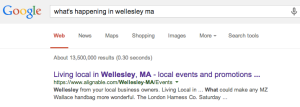By Eric Groves
Before picking a date for a promotion or event it’s important to understand how the various online resources at your disposal can work for your business. Since you want to attract and catch the attention of new customers, it’s important to understand how they find information and — more importantly — how to ensure information shows up when and where they are looking.
When individuals look for information about events and promotions that might be of interest, they typically look in one of two places: online search engines (ponds of information) and social media (rivers of information).
Search Engines – Fishing in a Pond
Google and other search engines are constantly crawling websites for relevant content for their users. I consider these to be ponds because your goal here is to stock the pond with information for when people go fishing for things to do. Here are two things you can do to ensure that your content will be found by search engines and shown to potential customers:
- Post your events and promotions to multiple webpages (your own website, Facebook, Town Calendars, etc). Your goal is for content to show up in relevant searches by potential customers, so the greater your distribution, the better the odds. In addition, collective websites like Alignable’s “Living Local Town Calendar” offer a single online place for people to visit to find out things to do and local events sponsored by the their local business community.

- It’s important to initially post your promotion or event with enough lead time to insure your content get’s indexed before the majority of traffic on search engines starts to ramp up. Based on our initial research, a lead-time of 45 days is sufficient. I am currently sorting through data and will provide a more comprehensive view on timing in an upcoming post.
Social Media – Fishing in a Stream
There’s a constant flow of information flowing through social media streams towards consumers and when you post content it joins the stream. If you are lucky, your content shows up in one of their streams; even luckier still and it will arrive when a prospective customer just happens to be looking for what you offer.
While consumers have some control over the information they see, companies like Google and Facebook also do a fair amount of content filtering on their own, making it difficult to know whether your content is reaching your desired audience. Not surprisingly, both of these companies offer the opportunity to pay to improve or boost your odds.
Email Marketing is the predictable and effective stream for reaching your existing customers. Assuming you follow best practices and send emails one or two times per month, you should be sure to include upcoming promotions and events at least twice before each event.
Ideally, coordinate the timing of emails with postings on your website. Here is a stream of email posts that you could follow: at least 45 days before the event, use a “Save the Date” type of reminder; the week prior to the event, send a “What’s Happening This Week” note, and if it’s a big event, send a “Reminder” email 24 hours before your event.
Facebook had been gaining momentum as a potential social media alternative to email marketing; however, recent changes by Facebook have made it more difficult for local businesses to count on content making it into the streams of the individuals who “like” the business. We still believe it’s worthwhile to post content to Facebook, but recognize the following:
- When you post content to your page, Facebook makes a determination on how broadly to push content to the pages of individuals who like your business.
- The more comments, shares and likes your posts get, the more visibility it gets.
- Unlike your website, customers are unlikely to return to your page to check out posts; rather they react to your posts that end up on their stream.
- A great way to get others to comment and share is for you to do it too. By checking out what other local businesses nearby are doing in the way of events and promotions and posting them to your page, you get conversations started (making you look more interesting to Facebook), become a valued resource for your followers and prime the pump for others to share on your behalf. We call this behavior “share to be shared.” Ideally look for events that are less than a week away for greatest impact.
Consider using this Facebook timeline for events and promotions:
- At least 45 days in advance, when you post your promotions and events to your website and via your email newsletter, share it on your Facebook stream as a “Save the Date” post.
- 7 days prior post an “Upcoming Event” post to Facebook in a manner that offers your followers the opportunity to comment on or share it.
- 24 hours prior, post a “Reminder” on Facebook to capture the impulse reaction.
Aligning Resources for Maximum Impact
Coordinating your resources will result in the maximum impact possible for events and promotions. Use this as a framework until you come up with the cadence that works best for you:
60 Days in Advance
- Tie into existing events, holidays or observances to help generate awareness for your event.
- Reach out to nearby local business owners who might be interested in participating with you on event.
- Finalize your plans.
45 Days in Advance
- Post promotions to your website, Facebook page and local calendar of events.
- Include a “Save The Date” post in your email newsletter about the event.
7 Days in Advance
- Post “Happening This Week” via all social media channels.
- Include information about your event in your email newsletter.
24 Hours in Advance
- Post “Reminder Tomorrow” via all social media channels.
24 Hours after Event
- Post pictures from your event to Facebook.
If you use Alignable, you can also share your promotions with other local business owners to help generate awareness and automatically update your website, Facebook page, the Town Calendar and Twitter account all with a single post.
Perhaps the Web hasn’t made your daily life more efficient and enjoyable up until now. But if you follow this guide, you’ll make significant improvements, based upon what I’ve seen with thousands of local businesses around the country.
Eric Groves is the co-founder and CEO of Alignable, the free social network for local businesses and organizations to connect and collaborate with others nearby. Eric has been a local marketing expert and enthusiast since 2001, authored The Constant Contact Guide to Email Marketing, and believes that local businesses are always stronger together.







